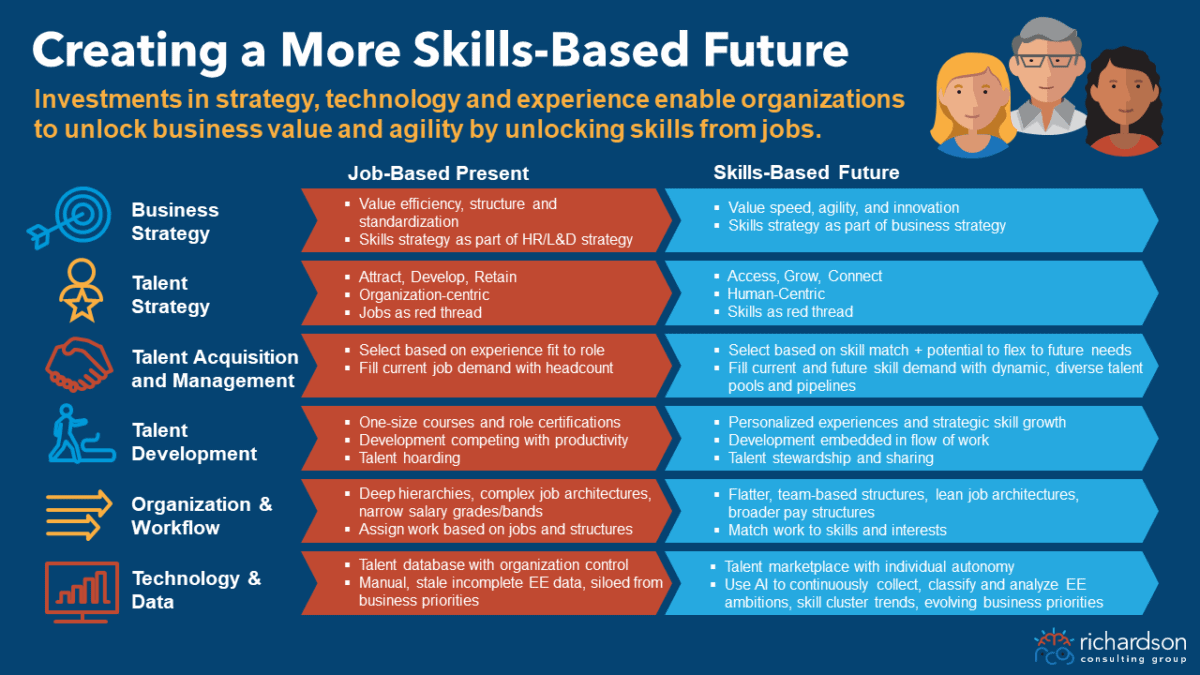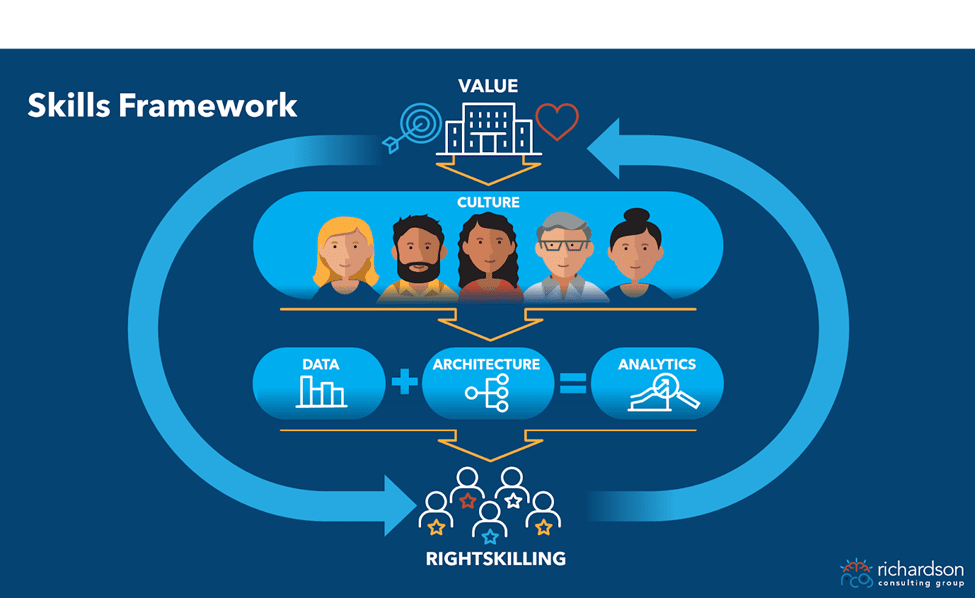
What is a Skills-Based Organization All About?
Creating a skills-based organization is a top priority for HR, learning and development, and the C-suite.
The key principle is moving from a job focus and mindset to skills. Associated term like “atomization of work” or “pixelization of work” sound fun, but what do they actually mean, and how can they be operationalized at scale?
It entails breaking down work into smaller units, enabling agility of various types and forms. However, it presents challenges of administration, governance, and scalability.
The concept of “skills” is not new, especially for HR, learning and development, and talent management professionals. But it is becoming more central to business strategy.
More business conversations are becoming skills conversations for example:
What skills do we need to launch a new product or enter a new market?
What skills do we need to serve our customers better? And more CEOs view skills as a strategic accelerator or a risk to strategy execution.

From a talent perspective, there is a shift from attracting, developing, and retaining people in jobs and roles to creating access to diverse pools and pipelines of talent and having more flexible relationships with them over time. Deep organizational hierarchies and complex job architectures are giving way to flatter, team-based structures, and leaner, more flexible job architectures.
From a technology and data perspective, skills data is becoming more visible to the whole organization instead of being locked away for only HR purposes.
Team members can now access and maintain their skills profile, and have direct access to learning, mentoring, project and career opportunities through talent marketplace and modern, skills-based learning platforms. They can also see the skills of other people and reach out to them for expertise or personal development. People leaders are also able to find the right candidates for roles or specific projects.
The Skills Strategic Framework: A Model for Building A Skills-Based Workforce
The conversation on skill building and skills-based organization calls for a structured skills strategy.
This framework encompasses critical elements in building a skills-based organization. These elements include right skilling, value-based approach, skills culture, skills architecture, and skills data.

The term “rightskilling” describes strategies to get the right skills to the right place at the right time.
Strategies for rightskilling include:
- Acquiring new talent (Buy)
- Upskilling existing talent (Build)
- Utilizing contingent labor (Borrow), or
- Employing strategic automation (Bot).
Organizations deploy these skilling strategies to create value for the business and the people in the business. Examples of business value include customer satisfaction, better products and services, business agility, and innovation. Skills also promote people value such as employee engagement, career satisfaction, and productivity.
Our roundtable discussion series also includes focused discussions on skills culture, data, architecture and analytics as elements of the strategic framework. Organizations are working on various elements and aspects of this theme at different rates and speeds.
Skills culture refers to how and what organizations do that either accelerates or inhibits the execution of skills strategy. It consists of values, beliefs, mindsets, and behaviors that either move skills forward or stand in the way of skill-based practices.
Skills data deals with questions of data access, storage, bias, privacy, security, and ethics. It is related but distinct from skills architecture which deals with questions of structure and relationships, which can be managed with skills taxonomies or ontologies.
Both data and architecture combine to help organizations derive actionable analytics on skills supply, demand, and gaps. They can also translate to predictive capabilities for future skill needs and gaps, especially with the use of AI-enabled tools.
Building a Skills Team and Advancing the Skills Discussion
Brian H., Founder and CEO of The Learning Forum asked our cross-industry team of experts, how many firms have a full-time skills czar. How many have a team?
He added additional context:
“The organizations we work with are large global companies with different pockets of skills engagement. For example, a look at their HR function shows different parts doing different things when it comes to skills. there is no governance model, no real ownership, and no dedicated team.”
This makes investment in skills difficult and highly unlikely to succeed. Some of these companies are starting to have a dedicated leader and team, but most do not.
These companies are jumping into skills with this little to no plan or preparation. This can work for an initial phase of small experiments but doesn’t allow for scaling a skills strategy.
More organizations are realizing a need to build more robust operating models for skills. Learning how others are doing it makes it easier for them as they talk to each other and share governance models and structure.
Marna, the Executive Director at Sisterweb, shared that her non-profit, community-based organization has a new workforce development department. The intention is to have three full-time people to support the organization with skills as a focus.
But from her previous career experience in the private industry, she is realizing the importance of a dedicated skills team for every business.
“There should be someone available to support skills building in every business, no matter the industry.”
She added that this is important for her organization because they have to develop a curriculum around the work they do. Skills building also promotes personal development for executives and career mobility for team leaders.
Gordon, a skills advocate and product strategist at SkillsThatWork, added that it is more about how to advocate and engage people across the organization that skills can be useful for them.
“How do you advocate and engage with people across the organization that skills can be useful for them? That’s slightly different but a very important role.”
His view is that, just as HR, finance, and sales teams are well-defined across organizations, the skills team also needs to be well-defined. Some organizations are posting for roles such as Skills Lead or Mobility Leads. But these are fairly recent and most organizations have not yet standardized on roles and responsibilities for skills.
How to Start the Skills Conversation
Jan-Willem, Managing Partner at Digital Skilled Professionals added his perspective on starting a skills strategy.
He is most often engaged by business leaders, who often view their internal HR as not equipped to start or manage a skills project.
Gordon related this to his experience with an insurance company. The first skills conversation started in HR. They developed a list of skills, connected them to learning, and invested in learning and development.
After the pilot program and having nurtured the conversation over time, they got a three-year investment and commitment from the executive committee to implement the program across the whole organization.
“.. too many skills projects that I’ve worked on have been led by those who acted with a sense of autonomy. And they worked without having the necessary HR buy-in.”
In the past, skills was part of learning and development exclusively. Then, the skills vendors rushed to IT groups clamoring for a solution to skills, hoping to land and expand to other parts of the organization.
Despite some targeted successes, this approach was not effective in broadening skills as a culture across the organization.
Jan-Willem added that he recently talked to a bank that started with skills management 2-3 years ago, but a skills strategy is still on the backlog.
He advised them to start with a skills strategy connected to business outcomes, and then communicate this to the board and other stakeholders.
Gordon explained that from his experience, skills technology vendors are sometimes part of the problem. Most software solutions are designed to address the low-hanging fruit in HR use cases for talent acquisition and self-directed learning.
These solutions chase the simple skills in the simplest mode and target HR buyers who don’t understand the broader business problems or values needing skills-based solutions.
Most HR-sponsored projects are measured against vanity HR metrics of candidates in the funnel or learning objects consumed. But those aren’t creating tangible business value.
For example, during layoffs, what is the capability risk of letting people go? Salesforce once let go of 7000 people but still had over 700 open positions on their website. Many of these open roles could have been filled by those people through cross-mapping skills and enabling mobility. But it was more of a finance-led expense reduction exercise and not an HR-led workforce optimization exercise, so the incentives were to reduce labor costs quickly and add new labor costs slowly.
Gordon’s example reminded me of some work with a client who started their skills strategy about 18 months into their rollout of a learning experience platform. This had enabled a digital learning strategy with curated plans, pathways, enhanced digital content, and more ways to access learning.
The platform had skills capabilities they didn’t enable during the initial rollout. When they did, they did not turn it on for the entire organization, but “village-by-village” starting a single function – finance. Finance was reimagining their function and developing a new capability model. This made them a natural proving ground for a skills strategy. Execution with this group helped build momentum, success and the start of a skills playbook that could be leveraged by the rest of the organization.
Final Word: Start with a Business Focus
These examples reinforced the value element in the skills strategy. Skills are not the end in and of themselves. They should enable and create tangible value aligned with business goals.
They also reinforced themes of many success stories shared during the roundtable series, which we’ve termed the 4S model for starting any skills program. Start simple, small, soon, and somewhere with a business need.
You can also start with a simple, lean operating model, create a skills-dedicated team, follow a village-by-village approach, and then scale your skills staffing, operations and budget as you scale your strategy to cover the whole organization.
If you’d like help with skills challenges in your organization, and you’d like to collaborate with cross-industry leaders on their skills journeys, join our next roundtable session. You can also book a 1:1 session with me if you prefer a more tailored approach.
